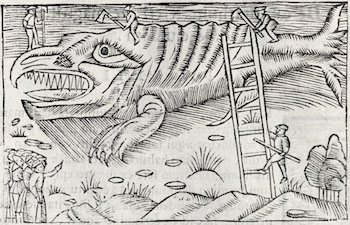In his three ichthyological publications, Historia Piscium (part IV of the Historiae Animalium - 1558), Nomenclator aquatilium animantium (1560), and Fischbuch (1563) Conrad Gessner described and depicted a range of miraculous creatures. While many of those, including various dried rays and the mythical hydra, Gessner denounced out-front as frauds, a specific group of eight monstrous creatures sighted in the North and the Baltic Sea is discussed in a more serious manner. These are classified under the cetaceans, and described as a distinct subgroup, further divided into further subgroups. On these creatures Gessner states they have been reported either so often or by such reliable sources that he cannot exclude the possibility that they exist.
Collectively these creatures are referred to as monstrum or, in German, Meerwunder (sea-miracles). In the Fischbuch, the group is subdivided into Meermenschen (“sea-people”, creatures with human features), and Meerthier (“sea-animals”, creatures resembling land-animals). It is clear that Gessner considered this specific group of species a complex one. In addition to descriptions of each of these creatures, Gessner included a general description of the subgroup as a whole. Similarly, he included a description of the entire group, which mentions the fabulous creatures, in an introduction to the cetaceans. The inclusion of such general descriptions is a tool Gessner applied whenever he dealt with a particularly complex group of species; this is done for example in his discussion of salmonids. This suggests he felt his organisation of cetaceans and miraculous creatures needed further explanation.
Several of Gessner's “sea-people” can be considered part human and part aquatic animal. Similarly many of his “sea-animals” can be considered part land-, part aquatic animal. All have in common that they resemble counterparts that live on land. In the general description Gessner lists characteristics that are shared by all members of the group: these creatures are large, most are live-bearing mammals, and all have lungs, testicles, kidneys, and bladders, and produce meat just as land animals. Throughout his ichthyological work Gessner includes animals into groups based on their physical characteristics. In fact, Gessner's presentation of these miraculous creatures is wholly consistent with his discussion of other aquatic animals in the structure and style of the descriptions.
With this list of characteristics in mind, it makes sense to organise such animals with the cetaceans. Also on other grounds it is relatively easy to see an overlap between the true cetaceans and the miraculous creatures. Gessner's cetaceans were for the larger part copied from Sebastian Munster and Olaus Magnus, and include a range of pig-, horse-, cow, and bird-like creatures. Gessner was sceptical about such depictions, both of true cetaceans and of miraculous creatures, and pointed out elements of the depictions that did not seem realistic to him. However he did not question the existence of the animals themselves, and backed this up with a meticulous list sources that describe them. Many of these reports may be the result of brief sightings of marine mammals such as the manatee and the seal. The line between “monsters” and otherwise little known creatures is consequently vague.
- Présentation
- Autre

 PDF version
PDF version

